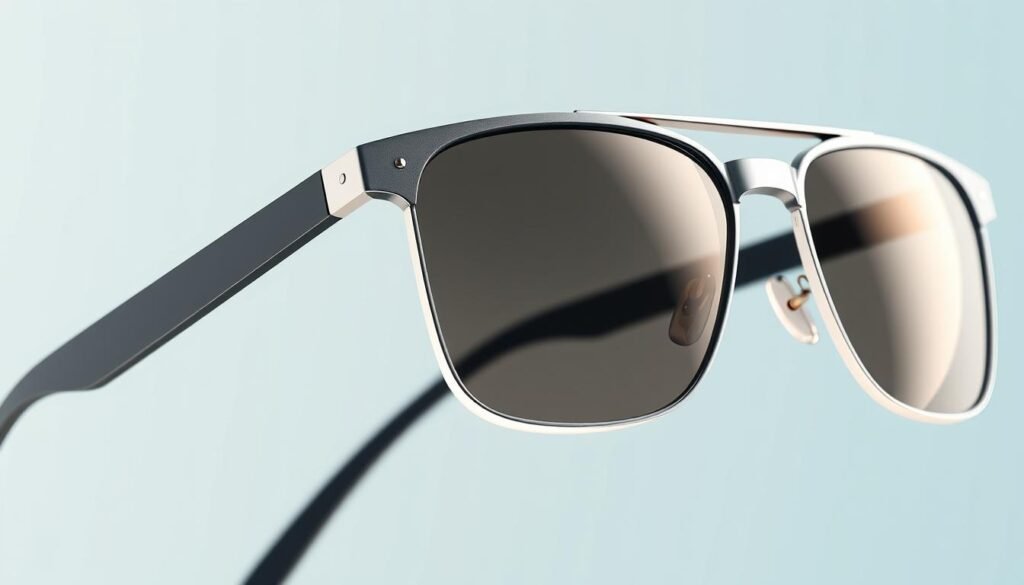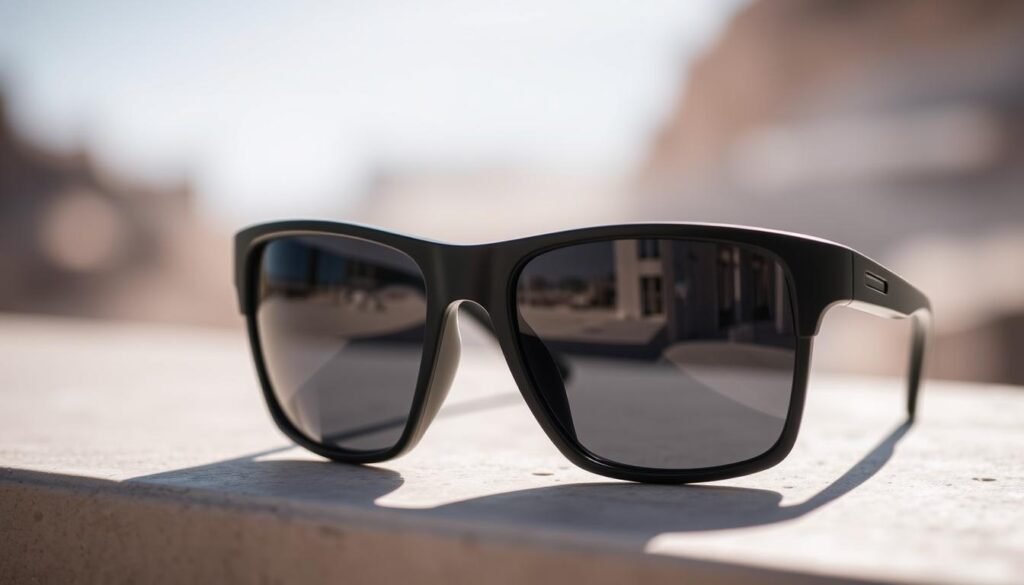Finding eyewear that truly safeguards your vision goes beyond style. Harmful UV rays pose real risks to eye health, making proper coverage essential. This guide helps you navigate features that matter, from lens technology to fit.
Ultraviolet radiation can damage delicate eye tissues over time. Quality options block 100% of UVA/UVB rays while offering comfort. We’ll break down how frame shape, lens material, and certifications work together to create effective barriers against sunlight.
You’ll learn why darkness doesn’t equal protection and how to verify claims. Whether hiking or driving, discover designs that blend safety with personal taste. Let’s explore how smart choices today can preserve your sight for years.
Key Takeaways
- UV-blocking lenses prevent long-term damage to cornea and retina
- Wrap-around frames reduce side exposure by up to 70%
- Look for “UV400” or “100% UV protection” labels
- Polarized lenses cut glare without weakening coverage
- Darker tints don’t necessarily block more radiation
- Regular checks ensure coatings remain effective
Introduction – Why Eye Protection Matters
Everyday environments hide risks that quality eyewear can mitigate effectively. Sunlight contains ultraviolet (UV) radiation – an invisible threat that penetrates clouds and bounces off surfaces like water and pavement. This constant exposure impacts both short-term comfort and long-term eye health.
The Importance of UV Protection for Your Eyes
UV rays damage more than skin. They can cause photokeratitis (sunburned eyes) and contribute to cataracts over time. Children’s developing eyes absorb 70% more UV radiation than adults’, making early protection habits crucial. Even brief exposure adds up, like deposits in a health savings account – but with withdrawals you never want to make.
An Overview of Eyewear and Safety Features
Modern eyewear does triple duty: blocking harmful rays, reducing glare, and shielding from wind/debris. Look for these features:
- UV400 labels indicating full UVA/UVB blockage
- Wraparound designs limiting side exposure
- Impact-resistant materials like polycarbonate
Remember: dark lenses without proper coatings can increase pupil dilation, letting in more harmful radiation. Always verify protection levels through certifications rather than assuming based on tint depth.
Understanding UV Radiation and Its Effects on the Eyes
Sunlight carries invisible threats that impact more than just your skin. Three types of ultraviolet radiation exist – UVA, UVB, and UVC. While Earth’s atmosphere blocks UVC rays, the other two types reach your eyes daily.

How Different Rays Affect Eye Structures
UVA rays penetrate deepest, reaching the macula at your retina’s center. This area handles detailed vision for reading and recognizing faces. Over time, this exposure contributes to macular degeneration.
UVB rays focus their energy on the eye’s lens. Like fog on a window, this leads to cloudiness called cataracts. Both conditions develop gradually, often showing symptoms years after initial damage.
| UV Type | Penetration Depth | Primary Impact |
|---|---|---|
| UVA | Retina/Macula | Central vision loss |
| UVB | Cornea/Lens | Cloudy vision |
| UVC | Blocked | No direct effect |
Eye Health Numbers That Demand Attention
The World Health Organization reports sobering data:
- 20% of cataract cases stem from UV exposure
- 10 million Americans show early macular degeneration signs
- Snow reflects 80% of UV rays, doubling winter risks
These statistics reveal how daily choices shape long-term vision health. Simple precautions today can significantly reduce risks of irreversible damage tomorrow.
Key Features of Most Protective Sunglasses
Selecting eyewear that combats sunlight’s dangers involves more than fashion preferences. Two critical elements determine effectiveness: UV-blocking capabilities and smart material choices. Let’s explore how these factors work together to shield your eyes.

Ensuring 100% UV and UV400 Protection
Always verify labels stating “100% UVA/UVB protection” or UV400 certification. These confirm lenses block all harmful rays up to 400 nanometers – the benchmark for complete coverage. Without this feature, even stylish frames leave eyes vulnerable to cumulative damage.
The Role of Polarization and Lens Materials
Polarized lenses tackle glare from water, roads, and snow without affecting UV defense. They’re ideal for drivers and outdoor enthusiasts. For materials:
- Polycarbonate: Naturally blocks 100% of rays, shatter-resistant
- Glass/Acrylic: Often require added coatings for full protection
Remember: Dark tints don’t guarantee safety. Clear lenses with proper coatings can outperform smoky ones lacking UV filters. Pair polarization with verified 100% protection for optimal comfort and defense against harmful rays.
Evaluating Lens Tints and Additional Coatings
Your eyewear’s lens color does more than influence style – it shapes how you see and interact with the world. Different tints filter light in unique ways, enhancing specific activities while maintaining crucial protection. Let’s explore how these choices impact daily comfort and visual performance.
Color Choices That Match Your Environment
Gray lenses act like neutral density filters. They reduce brightness evenly across all colors, making them ideal for beach days or urban settings where true color perception matters. Drivers often prefer brown or amber tints – these warm hues boost contrast, helping spot potholes or trail obstacles faster.
Green lenses offer the sharpest detail recognition. Golfers love them for tracking white balls against grassy backdrops. For snowy slopes or bright water, mirrored coatings add extra glare defense without altering color accuracy.
Smart Layers for Lasting Performance
Modern coatings work like invisible shields. Anti-reflective treatments cut distracting flashes from screens and headlights. Scratch-resistant layers keep lenses clear despite keys jangling in your bag. Remember: UV-blocking technology should always form the base layer, regardless of added features.
Pairing the right tint with complementary coatings creates eyewear that adapts to your life. A hiker might choose amber lenses with anti-fog treatment, while a cyclist could opt for photochromic lenses that adjust to changing light conditions. Always prioritize certified UV protection – it’s the foundation every other feature builds upon.
Frame Design, Fit, and Coverage for Maximum Protection
The right frames act as your first line of defense against scattered UV rays. While lens quality matters, gaps around poorly fitting eyewear can undo their benefits. Think of your frames as architectural blueprints – their shape determines how well they block light from all directions.
Wraparound and Large Frame Options for Better Side Protection
Curved designs create a dome-like shield around your eyes. Unlike flat-front styles, these:
- Block 25% more peripheral light
- Prevent windblown debris from sneaking in
- Stay secure during active movements
Oversized frames work similarly by covering more facial real estate. A study found they reduce UV exposure to delicate eyelid skin by 60% compared to narrow options. When testing fit:
| Fit Check | Good Sign | Red Flag |
|---|---|---|
| Nose pads | Even pressure | Leaving marks |
| Temple arms | Snug behind ears | Slipping forward |
| Lens position | No cheek contact | Touching lashes |
Your pair should feel like a second skin – present but unnoticed. If light peeks through the sides when facing forward, consider styles with adjustable nose pads or spring hinges. Remember: coverage trumps trends when shielding your eyes from the sun’s angled rays.
Activity-Specific Sunglasses and Lifestyle Considerations
Your daily routines and hobbies shape what you need from eyewear. Whether scaling mountain trails or navigating city streets, specialized features enhance both safety and comfort.
Tailored Options for Active Lifestyles
Water sports demand lenses that handle intense reflections. Polarized options cut through surface glare on lakes and oceans, improving visibility for kayakers and anglers. Angled frames prevent splashes from disrupting your view during high-speed activities.
Drivers benefit from brown or copper tints that maintain traffic light clarity while reducing road glare. Look for wraparound designs that block side reflections from other vehicles. For runners and cyclists, lightweight materials like Grilamid® keep frames secure during sudden movements.
Style Meets Function in Daily Wear
Urban dwellers often need eyewear that transitions smoothly from parks to pavement. Photochromic lenses adapt to shifting light levels, eliminating frequent swaps between regular glasses and sun pairs. Mirror coatings add flair while deflecting extra brightness in snowy or beach settings.
Professional environments call for subtlety. Rectangular frames in gunmetal or tortoiseshell offer UV defense without clashing with office attire. Remember: your lifestyle determines whether you prioritize sport-ready durability or fashion-forward versatility.
Practical Tips for Choosing the Right Pair
Smart selection starts with decoding labels and prioritizing fit. Labels tell the real story about UV defense – ignore vague claims and hunt for concrete certifications.
Reading Labels and Verifying 100% Protection Claims
Always seek “UV400” or “100% UV protection” markings. These guarantee full blockage of harmful rays up to 400nm. Check lenses against bright light – quality ones show zero distortion.
For children’s eyewear, prioritize flexible frames that survive playground tumbles. Their developing eyes need extra shielding – gaps around temples let in 45% more stray light according to recent studies.
Consulting Eye Care Experts for Personalized Recommendations
Optometrists assess your facial structure and lifestyle needs. They’ll suggest materials like TR-90 plastic for athletes or acetate for all-day comfort. Prescription wearers get tailored solutions merging vision correction with sun defense.
Remember: The best sunglasses feel weightless yet secure. Test them by nodding sharply – if they slip, try adjustable nose pads. Your eyes deserve this combo: verified protection + personalized fit.

